Economy of Malawi
The economy of Malawi is $7.522 billion by gross domestic product as of 2019, and is predominantly agricultural, with about 80% of the population living in rural areas. The landlocked country in south central Africa ranks among the world's least developed countries. In 2017, agriculture accounted for about one-third of GDP[13] and about 80% of export revenue. The economy depends on substantial inflows of economic assistance from the IMF, the World Bank, and individual donor nations. The government faces strong challenges: to spur exports, to improve educational and health facilities, to face up to environmental problems of deforestation and erosion, and to deal with the problem of HIV/AIDS in Africa. Malawi is a least developed country according to United Nations.
 Lilongwe, the financial centre of Malawi | |
| Currency | Malawian kwacha (MWK) |
|---|---|
| 1 July - 30 June | |
Trade organisations | AU, AfCFTA (signed), WTO, SADC, COMESA |
Country group |
|
| Statistics | |
| GDP | |
| GDP rank | |
GDP growth |
|
GDP per capita | |
GDP per capita rank | |
GDP by sector | agriculture 29.4%, industry 15.8%, services 56.1% (2016 est.) |
| 8.4% (2020 est.)[3] | |
Population below poverty line | |
| 44.7 medium (2016)[7] | |
Labour force | |
Labour force by occupation | agriculture: 76.9%, industry: 4.1%, services: 19% (2013 est.) |
| External | |
| Exports | $1.443 billion (2017 est.) |
Export goods | tobacco (55%), dried legumes (8.8%), sugar (6.7%), tea (5.7%), cotton (2%), peanuts, coffee, soy (2015 est.) |
Main export partners | Zimbabwe 13.1%, Mozambique 11.8%, Belgium 10.7%, South Africa 6.3%, Netherlands 5%, UK 4.7%, Germany 4.3%, US 4.2% (2017) |
| Imports | $2.388 billion (2017 est.) |
Import goods | food, petroleum products, semi-manufactures, consumer goods, transportation equipment |
Main import partners | South Africa 20.7%, China 14.2%, India 11.6%, UAE 7%, Netherlands 4.4% (2017) |
FDI stock | $129.5 million (2014) |
Gross external debt | $1.861 billion (2017 est.) |
| Public finances | |
| 50.8% of GDP (2013 est.) | |
| Revenues | $1.347 billion (2013 est.) |
| Expenses | $1.4 billion (2013 est.) |
| Economic aid | $1.174 million (2012) |
| $364.2 million (31 December 2013 est.) | |
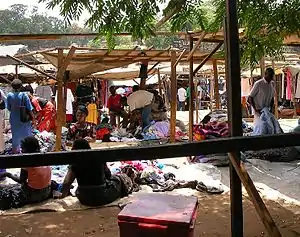
Agriculture
Malawi's most important export crop is tobacco, which accounted for a third (30%) of export revenue in 2012.[14] In 2000, the country was the tenth-largest producer in the world. The country's heavy reliance on tobacco places a heavy burden on the economy as world prices decline and the international community increases pressure to limit tobacco production. Malawi's dependence on tobacco is growing, with the product jumping from 53% to 70% of export revenues between 2007 and 2008.[15][16]
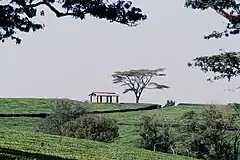
The country also relies heavily on tea, sugarcane and coffee, with these three plus tobacco making up more than 90% of Malawi's export revenue. Tea was first introduced in 1878. Most of it is grown in Mulanje and Thyolo. Other crops include cotton, corn, potatoes, sorghum, cattle and goats. Tobacco and sugar processing are notable secondary industries.
Traditionally Malawi has been self-sufficient in its staple food, maize (corn), and during the 1980s it exported substantial quantities to its drought-stricken neighbors. Nearly 90% of the population engages in subsistence farming. Smallholder farmers produce a variety of crops, including maize, beans, rice, cassava, tobacco, and groundnuts (peanuts). Financial wealth is generally concentrated in the hands of a small elite. Malawi's manufacturing industries are situated around the city of Blantyre.
Lake Malawi and Lake Chilwa provide most of the fish for the region. For many Malawians, fish is the most important source of proteins. Dried fish is not only consumed locally, but also exported to neighboring countries. Most fishing is done on small scale by hand. However, Maldeco Fisheries owns several commercial fishing boats and operates fish farms in the southern part of Lake Malawi.
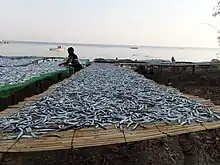
Malawi has few exploitable mineral resources. A South-African Australian consortium exploits uranium at a mine near Karonga. Coal is being extracted in Mzimba District. Malawi's economic reliance on the export of agricultural commodities renders it particularly vulnerable to external shocks such as declining terms of trade and drought. High transport costs, which can comprise over 30% of its total import bill, constitute a serious impediment to economic development and trade. Malawi must import all its fuel products. Other challenges include a paucity of skilled labor, difficulty in obtaining expatriate employment permits, bureaucratic red tape, corruption, and inadequate and deteriorating road, electricity, water, and telecommunications infrastructure which hinder economic development in Malawi. However, recent government initiatives targeting improvements in the road infrastructure, together with private sector participation in railroad and telecommunications, have begun to render the investment environment more attractive.

The following are Malawi's top 20 agricultural production values and volumes for 2009. (Unofficial figures derived from FAO statistics) [17]
| Commodity | Production in International dollars (1000) | Production in tonnes | FAO source |
|---|---|---|---|
| Maize | 462,330 | 3,582,500 | |
| Cassava | 404,764 | 3,823,240 | |
| Tobacco | 331,542 | 208,155 | |
| Groundnuts | 116,638 | 275,176 | |
| Bananas (excluding plantains) | 95,152 | 400,000 | F |
| Sugar cane | 82,093 | 2,500,000 | F |
| Indigenous cattle meat | 80,688 | 0 | |
| Pigeon peas | 80,274 | 184,156 | |
| Beans, dry | 75,706 | 164,712 | |
| Fresh fruit | 74,456 | 213,321 | Im |
| Plantains | 72,634 | 351,812 | Im |
| Indigenous pig meat | 68,788 | 0 | |
| Tea | 55,895 | 52,559 | P |
| Indigenous goat meat | 53,512 | 0 | |
| Mangoes, mangosteens and guavas | 49,527 | 82,659 | Im |
| Cotton lint | 39,017 | 27,300 | F |
| Paddy rice | 36,896 | 135,988 | |
| Fresh vegetables | 30,530 | 162,012 | Im |
| Indigenous chicken meat | 25,713 | 0 | |
| Cow peas | 18,073 | 72,082 |
Key: F : FAO estimate, Im: FAO data based on imputation methodology, P : Provisional official data
Macro-economic trends
The following table shows the main economic indicators in 1980–2017.[18]
| Year | 1980 | 1985 | 1990 | 1995 | 2000 | 2005 | 2006 | 2007 | 2008 | 2009 | 2010 | 2011 | 2012 | 2013 | 2014 | 2015 | 2016 | 2017 |
|---|---|---|---|---|---|---|---|---|---|---|---|---|---|---|---|---|---|---|
| GDP in $ (PPP) |
2.42 bil. | 3.46 bil. | 4.52 bil. | 5.75 bil. | 7.73 bil. | 9.76 bil. | 10.53 bil. | 11.85 bil. | 13.00 bil. | 14.19 bil. | 15.35 bil. | 16.43 bil. | 17.05 bil. | 18.22 bil. | 19.61 bil. | 20.40 bil. | 21.13 bil. | 22.37 bil. |
| GDP per capita in $ (PPP) |
368 | 449 | 450 | 539 | 640 | 714 | 750 | 820 | 876 | 929 | 977 | 1,016 | 1,025 | 1,065 | 1,114 | 1,127 | 1,134 | 1,167 |
| GDP growth (real) |
0.4 % | 4.6 % | 5.7 % | 13.8 % | 0.8 % | 3.3 % | 4.7 % | 9.6 % | 7.6 % | 8.3 % | 6.9 % | 4.9 % | 1.9 % | 5.2 % | 5.7 % | 3.0 % | 2.3 % | 4.0 % |
| Inflation (in Percent) |
19.2 % | 10.6 % | 11.9 % | 83.1 % | 29.6 % | 15.4 % | 13.9 % | 8.0 % | 8.7 % | 8.4 % | 7.4 % | 7.6 % | 21.3 % | 28.3 % | 23.8 % | 21.9 % | 21.7 % | 11.5 % |
| Government debt (Pct. of GDP) |
... | ... | ... | ... | ... | 107 % | 28 % | 28 % | 36 % | 36 % | 30 % | 31 % | 44 % | 59 % | 55 % | 61 % | 60 % | 59 % |
Industry
In 2013, Malawi's manufacturing sector contributed 10.7% of GDP.[19] The main industries are food processing, construction, consumer goods, cement, fertilizer, ginning, furniture production and cigarette production.
The government's attempts to diversify the agriculture sector and move up the global value chain have been seriously constrained by poor infrastructure, an inadequately trained work force and a weak business climate. In order to help companies adopt innovative practices and technologies, the National Export Strategy adopted in 2013 affords companies greater access to the outcome of international research and better information about available technologies; it also helps companies to obtain grants to invest in such technologies from sources such as the country's Export Development Fund and the Malawi Innovation Challenge Fund. In parallel, the government has raised its investment in research and development to 1% of GDP.
Food and beverages
Most fruits and vegetables are exported raw, while processed food is imported mainly from South Africa. Carlsberg opened its first brewery outside of Denmark in Blantyre in 1965. The brewery also bottles Coca-Cola products under licence. A mango processing plant for the export of fruit concentrate opened in Salima in 2013. Universal Industries operates several food factories in Blantyre, where it produces sweets, crisps, biscuits, milk powder, soy products and baby food. Coffee and tea are processed by half a dozen of different companies in the regions of Thyolo, Mulanje and around Mzuzu.
Pharmaceutical companies
Malawi has four pharmaceutical companies. They manufacture a limited range of drugs, particularly those that are in great demand on the local market.[20] These are Pharmanova Ltd.,[20] which is the biggest pharmaceutical manufacturer in Malawi, followed by SADM, Malawi Pharmacies (Pharmaceuticals Limited) and Kentam Products Limited.[20]
Forestry
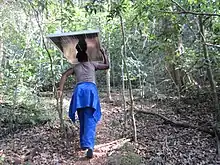
Large man-made pine tree forests are located in the Viphya Mountains, around Mulanje and Zomba. Timber production for building materials and furniture is an important industry for these regions. However, most areas in Malawi suffer from deforestation due to illegal logging for charcoal production and the use of firewood.
Electricity
Malawi's sole power supplier is the state owned Electricity Supply Commission of Malawi (ESCOM), which generates almost all its power from hydroelectric plants along the Shire River. The installed is approximately 351MW.[21] About 12% of the country's population has access to electricity, according to 2014 World Bank figures.[22]
The country has been suffering from intermittent power outages as a result of an ongoing drought that has halved power output as water levels of the Shire river dropped significantly.[23] The river usually generates 300MW of electricity, accounting for 98% of Malawi's total supply. However, the drought reduced that capacity to 160MW, according to ESCOM.[23]
Services
The service sector accounts for 51.7% of Malawi's national GDP. Notable industries are tourism, retail, transport, education, health services, telecommunication and the banking sector. The Government of Malawi holds shares in many important companies, such as Malawian Airlines (51%) and Press Corporation Limited. Press Corporation Ltd. is the country's biggest company, with subsidiaries in the tobacco, banking, sugar, fishing, ethanol production, steel production, retail, telecommunication and petrol sectors.
International support
Malawi has undertaken economic structural adjustment programs supported by the World Bank (IBRD), the International Monetary Fund (IMF), and other donors since 1981. Broad reform objectives include stimulation of private sector activity and participation through the elimination of price controls and industrial licensing, liberalization of trade and foreign exchange, rationalization of taxes, privatization of state-owned enterprises, and civil service reform. Malawi qualified for Heavily Indebted Poor Country (HIPC) debt relief and is in the process of refining its poverty reduction strategy.
Malawi has bilateral trade agreements with its two major trading partners, South Africa and Zimbabwe, both of which allow duty-free entry of Malawian products into their countries. The government faces challenges such as the improvement of Malawi's educational and health facilities — particularly important because of the rising rates of HIV/AIDS — and environmental problems including deforestation, erosion, and overworked soils.

Move towards economic independence
In 2006, in response to disastrously low agricultural harvests, Malawi, through an initiative by the late President Bingu Mutharika, an economist by profession, began a program of fertilizer subsidies that were designed to re-energize the land and boost crop production. It has been reported that this program, championed by the country's president, is radically improving Malawi's agriculture, and causing Malawi to become a net exporter of food to nearby countries.[24]
Economic grievances though took a downward slide during Mutharika's second term. Economic grievances were a catalyst that resulted in the 2011 economic protests in Malawi in July.
Economic indicators
The following figures are taken from the CIA World Factbook,[13] unless otherwise indicated.
GDP: purchasing power parity = $22.37 billion (2017 est.)

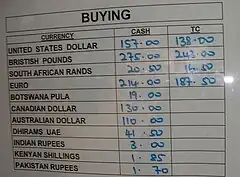

GDP - real growth rate: 4% (2017 est.)
GDP - per capita: purchasing power parity - $1200 (2017 est.)
GDP - composition by sector:
agriculture:
28.1%
industry:
15.8%
services:
56.1% (2016 est.)
Population below poverty line: 50.7% (2010 est.)
Inflation rate (consumer prices): 23% (2014 est.)
Labor force: 7 million (2013 est.)
Labor force - by occupation: agriculture 76.9%, industry and services 23.1% (2013 est.)
Unemployment rate: NA%
Budget:
revenues:
$1.346 billion (2017 est.)
expenditures:
$1.556 billion (2017 est.)
Public Debt 59.3% of GDP (2017 est.)
Industries: tobacco, tea, sugar, sawmill products, cement, consumer goods, cotton, consumer goods, uranium and coal mining
Industrial production growth rate: 2.8% (2013 est.)
Electricity - production: 1.973 billion kWh (2010 est.)
Electricity - consumption: 1.835 billion kWh (2010 est.)
Agriculture - products: tobacco, sugar cane, cotton, tea, maize, potatoes, cassava (tapioca), sorghum, pulses; cattle, goats
Exports: $1.427 billion (2013 est.)
Exports - commodities: tobacco, tea, sugar, cotton, coffee, peanuts, wood products, apparel, uranium and its compounds
Exports - partners: Canada 10.6%, Zimbabwe 9.3%, Germany 7.3%, South Africa 6.6%, Russia 6.5%, US 6.1%, China 4.2% (2012)
Imports: $2.42 billion (2013 est.)
Imports - commodities: food, petroleum products, semimanufactures, consumer goods, transportation equipment
Imports - partners: South Africa 27%, China 16.6%, India 8.7%, Zambia 8.5%, Tanzania 5.1%, US 4.3% (2012)
Current account balance - $280.1 million (2013 est.)
Debt - external: $1.556 billion (31 December 2013 est.)
Economic aid - recipient:
$575.3 million (2005)
Foreign direct investment - inflow $129.5 million (2014)
Currency: 1 Malawian kwacha (MK) = 100 tambala
Exchange rates: Malawian kwachas per US dollar -730.00 (20/June/2016), 460.00 (20/Jan/2015), 360.00 (6/Feb/2013), 165.961 (1/Sep/2011), 145.179 (2009), 135.96 (2006), 108.894 (2005), 108.898 (2004), 97.433 (2003), 76.687 (2002)
Fiscal year: 1 July - 30 June
See also
References
- "World Economic Outlook Database, April 2019". IMF.org. International Monetary Fund. Retrieved 29 September 2019.
- "World Bank Country and Lending Groups". datahelpdesk.worldbank.org. World Bank. Retrieved 29 September 2019.
- "World Economic Outlook Database, October 2019". IMF.org. International Monetary Fund. Retrieved 22 January 2020.
- "Global Economic Prospects, January 2020 : Slow Growth, Policy Challenges" (PDF). openknowledge.worldbank.org. World Bank. p. 147. Retrieved 22 January 2020.
- "Poverty headcount ratio at national poverty lines (% of population) - Malawi". data.worldbank.org. World Bank. Retrieved 5 February 2020.
- "Poverty headcount ratio at $1.90 a day (2011 PPP) (% of population) - Malawi". data.worldbank.org. World Bank. Retrieved 5 February 2020.
- "GINI index (World Bank estimate) - Malawi". data.worldbank.org. World Bank. Retrieved 5 February 2020.
- "Human Development Index (HDI)". hdr.undp.org. HDRO (Human Development Report Office) United Nations Development Programme. Retrieved 11 December 2019.
- "Inequality-adjusted Human Development Index (IHDI)". hdr.undp.org. HDRO (Human Development Report Office) United Nations Development Programme. Retrieved 11 December 2019.
- "Labor force, total - Malawi". data.worldbank.org. World Bank & ILO. Retrieved 5 February 2020.
- "Employment to population ratio, 15+, total (%) (national estimate) - Malawi". data.worldbank.org. World Bank. Retrieved 5 February 2020.
- "Ease of Doing Business in Malawi". Doingbusiness.org. Retrieved 2017-01-24.
- "CIA World Factbook". CIA. 3 March 2022.
- African Economic Outlook. African Development Bank, Organisation for Economic Cooperation and Development and United Nations Development Programme. 2014.
- CIA World Factbook
- J. Tyler Dickovick, Africa 2008, 43rd edition, Harpers Ferry, WV: Stryker-Post Publications, 2008. p. 278
- "Faostat".
- "Report for Selected Countries and Subjects". Retrieved 2018-08-29.
- "World Bank's World Development Indicators". World Bank. April 2015.
- A Survey of Policy and Practice on the Use of Access to MedicinesRelated TRIPs Flexibilities in Malawi
- "Malawi hit by blackout as falling dam levels drain hydropower". Reuters. 8 December 2017. Retrieved 8 December 2017.
- "Access to electricity (% of population) | Data". data.worldbank.org. Retrieved 2017-12-08.
- "Malawi suffers blackouts as drought exposes 98% reliance on hydro power". The Guardian. Agence France-Presse. 2017-12-08. ISSN 0261-3077. Retrieved 2017-12-08.
- Dugger, Celia W. (December 2, 2007). "Ending Famine, Simply by Ignoring the multilateral organisation 'Experts'". The New York Times. Retrieved 2008-08-05.
![]() This article incorporates public domain material from The World Factbook. CIA.
This article incorporates public domain material from The World Factbook. CIA.
Further reading
- Anthony and Doreen Young, A Geography of Malawi, Second edition. Evans Brothers, Limited, London (1978) ISBN 0-237-50296-8